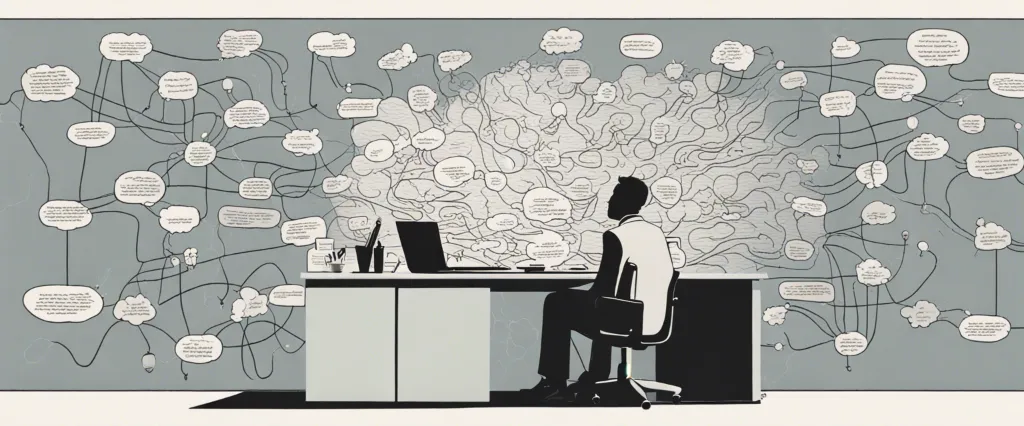In her transformative book, “Working Identity,” Herminia Ibarra delves into the complex journey of professional reinvention. With extensive research and personal anecdotes, Ibarra explores how individuals can navigate career transitions while remaining true to their authentic selves. As a renowned organizational behavior professor at London Business School, Ibarra brings a wealth of expertise and insights to help readers understand the opportunities and challenges of recreating one’s professional identity. Through her groundbreaking work, she enlightens individuals on the importance of exploring new possibilities, embracing ambiguity, and fostering a growth mindset in order to forge a fulfilling and successful career path.
Chapter 1: The Challenge of Career Change
Chapter 1: The Challenge of Career Change of the book Working Identity by Herminia Ibarra explores the difficulties and complexities individuals face when navigating a career change. Ibarra argues that traditional approaches to career change, which emphasize rational decision-making and strategic planning, are inadequate in today’s rapidly evolving work environment.
The chapter begins by spotlighting the experiences of several professionals who embarked on career transitions. These stories illustrate the various motivations for change, ranging from dissatisfaction with their current roles to a desire for personal growth and fulfillment. Ibarra emphasizes that career transitions are not linear or predictable but often involve exploring multiple paths, taking risks, and experiencing doubt and uncertainty.
The author discusses the various challenges individuals encounter in career transitions, including the struggle to disengage from their previous identities and the difficulty in exploring new career options without a clear vision of their desired future selves. Ibarra introduces the concept of “possible selves, ” which are the various identities individuals can imagine for themselves in different careers. She argues that experimenting with different roles and engaging in new activities is crucial for discovering and shaping these possible selves.
Ibarra challenges the traditional notion that introspection and self-reflection are sufficient for career change. She emphasizes the importance of external experimentation, such as networking, joining professional groups, and taking on new projects, to gain firsthand experience and acquire knowledge about different careers. Through these external experiments, individuals can refine and test their possible selves.
Overall, Chapter 1 highlights the complexities and emotional challenges faced by individuals seeking to make a career change. It sets the foundation for the rest of the book, which will delve deeper into the multiple strategies and approaches individuals can employ to successfully navigate career transitions in the modern work environment.
Chapter 2: The Seduction of the Ideal Self
Chapter 2 of “Working Identity” by Herminia Ibarra, titled “The Seduction of the Ideal Self,” explores how individuals often become stuck in their current careers because they are attached to a personal image or identity they have built around their work, even if it no longer aligns with their true passions or aspirations.
Ibarra argues that society places immense pressure on individuals to have a solid and defined identity, especially in the context of their careers. Many people develop an idealized perception of the perfect self they envision in their professional lives, which includes specific roles, skills, and accomplishments. This ideal self is often influenced by societal expectations, family pressure, or perceptions of success.
People get attached to their idealized career self, known as the “true self.” This true self is rooted in past achievements and accumulated experience, making it difficult to let go even when it no longer brings fulfillment. As a result, individuals might cling to their current careers, feeling trapped, instead of exploring new opportunities.
The chapter also mentions that career transitions are not just about finding the right job but also about understanding and reshaping one’s identity. Ibarra argues that mere analysis and introspection are insufficient for reinventing oneself. Rather, individuals need to explore new experiences and relationships that challenge their existing assumptions and beliefs. This process can help in constructing a more accurate and realistic working identity that aligns with one’s true passions and aspirations.
Overall, the chapter emphasizes the importance of questioning and challenging the idealized self to break free from career constraints and explore new possibilities. By letting go of the “true self” and embracing a more fluid and evolving identity, individuals can find the courage to pursue careers that truly bring them joy and satisfaction.
Chapter 3: The Dreamer and the Critic
Chapter 3 of “Working Identity” by Herminia Ibarra, titled “The Dreamer and the Critic,” focuses on examining the inner selves we inhabit throughout our professional lives. Ibarra argues that our identities are not fixed or predetermined, but are constantly evolving and influenced by our experiences and interactions with others.
The chapter presents two opposing roles that individuals often embody when seeking a career change: the Dreamer and the Critic. The Dreamer is the optimistic self who imagines new possibilities and explores different career paths. This self is often fueled by inspiration and a desire for growth and change. However, this idealistic vision is often countered by the Critic, the rational and analytical self that questions and doubts the viability and practicality of these dreams.
Ibarra highlights the tension between these two roles, asserting that the Critic tends to dominate in times of transition due to fear and uncertainty. This inner conflict becomes a barrier to discovering and pursuing new professional identities. The author emphasizes the importance of acknowledging and balancing both the Dreamer and the Critic, as they play crucial roles in shaping our professional narratives.
To embrace our working identities, Ibarra suggests taking small steps towards experimenting with new roles or interests. By immersing oneself in new experiences and networks, individuals can challenge the assumptions and limitations imposed by their current professional identity. Ultimately, this process enables them to construct and achieve a more fulfilling and authentic working identity that aligns with who they truly are.
Overall, Chapter 3 emphasizes the significance of recognizing and reconciling the competing forces within ourselves to navigate career transitions successfully. By embracing both the Dreamer and the Critic, individuals can transcend their current professional selves, explore new possibilities, and find meaning and satisfaction in their work lives.
Chapter 4: The Politics of Transition

Chapter 4: The Politics of Transition from the book “Working Identity” by Herminia Ibarra dives into the complex dynamics of transitioning to a new career or identity and the political challenges that arise during this process. Ibarra argues that career transitions are not simply personal ventures but are also deeply intertwined with the social and political networks individuals are part of.
The chapter begins by emphasizing how an individual’s reputation, relationships, and identity within their current organization can become constraints when attempting to transition into a new career. Ibarra explains that one of the key obstacles is the social pressure to maintain a consistent identity and conform to established norms within one’s existing professional network. However, she emphasizes that transitioning to a new career often requires experimentation, exploration, and the cultivation of new relationships outside the comfort zone of one’s existing network.
Ibarra introduces the concept of “redesigning your job” and advocates for engaging in new activities within one’s current role to expand one’s skill set and network. She also emphasizes that it is crucial to connect with diverse groups of people outside one’s immediate professional circle to gain different perspectives and access opportunities in the desired field. By immersing oneself in unfamiliar contexts, individuals can gain valuable insights that will help them redefine their working identity and mitigate the potentially negative consequences of career transition.
Furthermore, the chapter highlights the importance of developing strategic alliances and leveraging social capital during a career transition. Ibarra emphasizes the need to build alliances with influential individuals who can help navigate the political landscape and provide access to valuable resources and opportunities. She advises individuals to be purposeful in cultivating these relationships and reciprocate by offering assistance and support to others.
Overall, Chapter 4 of “Working Identity” sheds light on the challenges individuals face when transitioning careers and highlights the significance of social networks, experimentation, and strategic alliances in navigating the complex politics of career transition. By understanding and effectively managing these dynamics, individuals can successfully transition to new identities and achieve long-term career satisfaction.
Chapter 5: The Craft of Transition
Chapter 5: The Craft of Transition from the book Working Identity by Herminia Ibarra delves into the process of transforming one’s career and identity. The chapter emphasizes the importance of actively experimenting with new ideas, roles, and networks as a means to discover a new professional identity.
Ibarra argues that transitioning to a new career is not a linear or solely introspective process. Rather, it is an exploratory and experimental journey. She suggests that individuals should engage in low-commitment “probes” that allow them to test out potential new roles or industries. These probes help individuals gain practical experience and learn what truly interests and motivates them.
Additionally, Ibarra highlights the significance of social networks in career transitions. She encourages individuals to actively seek out new connections, join different professional networks, and engage in diverse communities. By doing so, they are exposed to new ideas, perspectives, and opportunities that can lead to unexpected career paths.
Ibarra introduces the concept of “bridging” and “linking” social capital as crucial tools for career transition. Bridging social capital involves reaching out to diverse individuals who can challenge existing beliefs and provide alternative viewpoints. Linking social capital, on the other hand, involves connecting with influential and powerful individuals who can provide access to new resources and opportunities.
The chapter concludes by emphasizing the importance of recognizing and embracing the iterative nature of the transition process. Ibarra asserts that individuals should not be discouraged by setbacks or the need to make multiple transitions. Instead, they should view these experiences as opportunities for growth, reflection, and learning.
In summary, Chapter 5: The Craft of Transition in Working Identity emphasizes the importance of actively experimenting, engaging in new social networks, and embracing the iterative nature of career transitions. By doing so, individuals can discover new professional identities and create meaningful and fulfilling careers.
Chapter 6: The Practice Turn
Chapter 6 of “Working Identity” by Herminia Ibarra, titled “The Practice Turn,” explores the importance of engaging in new practices and behaviors when transitioning into a new career or identity. Ibarra emphasizes that individuals cannot solely rely on introspection or personal reflection to make successful career transitions; they must actively immerse themselves in new experiences and behaviors to develop a new professional identity.
The chapter begins by highlighting the limitations of self-reflection, arguing that too much introspection often leads to indecisiveness and a lack of progress. Instead, Ibarra advocates for action-based learning, where individuals experiment with new activities and roles that align with their aspirations. By engaging in these new practices, individuals gain new insights about their career preferences, strengths, and weaknesses.
Ibarra emphasizes the significance of “outsider” practices, which involve seeking and adopting practices that are outside of one’s current professional or social environment. This type of experimentation allows individuals to explore different facets of their identity and helps them break away from the constraints of their previous roles.
The chapter also introduces the concept of “identity play,” in which individuals temporarily adopt different roles and behaviors to broaden their professional repertoire. Through identity play, individuals can test out new behaviors and learn from the experiences, enabling them to adapt and shape their emerging identity.
Moreover, Ibarra stresses the importance of engaging in social networks and communities that support the desired identity. By surrounding oneself with like-minded individuals, individuals can gain valuable insights, feedback, and opportunities for growth.
In summary, Chapter 6 of “Working Identity” highlights the practice turn in career transitions, emphasizing that individuals need to engage in new practices, adopt outsider perspectives, and experiment with different roles and behaviors to develop a successful new professional identity. Through action-based learning, individuals gain valuable insights, expand their professional repertoire, and build social networks that support their desired identity.
Chapter 7: The Challenge of Integration
Chapter 7: The Challenge of Integration from the book “Working Identity” by Herminia Ibarra explores the difficulties individuals face when trying to integrate a new professional identity. The chapter focuses on the challenges of incorporating a new work identity into one’s existing identity framework.
Ibarra begins by highlighting the fact that integrating a new identity is often harder than adopting it in the first place. This is because people tend to compartmentalize their identities, separating their personal and professional selves. As a result, when individuals attempt to fully embrace a new work identity, they may encounter resistance from their existing identity structures.
The author emphasizes that successful integration requires a gradual and purposeful process. This can involve actively seeking out opportunities to practice the new identity, such as taking on new responsibilities or projects. By immersing themselves in the new role, individuals develop a deeper understanding of their new identity and begin to reshape their existing sense of self.
Ibarra also explores the importance of feedback in the integration process. Seeking feedback from others allows individuals to gain insights into how they are perceived in their new role and make adjustments accordingly. This feedback loop helps bridge the gap between old and new identities, enabling individuals to align their actions and behaviors with their desired professional identity.
Additionally, the chapter highlights the role of social networks in integration. Building relationships with individuals who embody the desired identity can provide valuable support and mentorship during the integration process. Exposure to these role models helps individuals broaden their understanding of the new identity and find ways to incorporate it more fully into their work lives.
In summary, the chapter emphasizes the challenges of integrating a new professional identity and provides practical strategies for successful integration. It highlights the need for purposeful and gradual adjustments, feedback, and the importance of social networks in navigating this complex process.

Chapter 8: The New You
Chapter 8: The New You from the book “Working Identity” by Herminia Ibarra explores the process of reinventing oneself in order to pursue a new professional identity. The chapter highlights the challenges individuals face when trying to make a significant career transition and provides guidance on effectively navigating through this process.
The chapter begins by emphasizing the importance of creating a compelling career story that aligns with the desired professional identity. Ibarra suggests that individuals should experiment with alternative selves by engaging in activities or projects related to their potential career paths. By doing so, they can gain a deeper understanding of their skills, interests, and values, while also building relationships with others in the desired industry.
Ibarra also emphasizes that it is crucial to resist the desire to search for the perfect career before making a transition. She advises professionals to embrace the idea of a provisional, evolving identity, and to recognize that clarity often emerges through action rather than introspection.
The author introduces the concept of “identity experiments,” explaining that individuals should actively explore different roles, projects, or teams to uncover potential career paths. This may involve taking on short-term assignments, seeking mentorship, or attending industry events to expand one’s network and increase exposure to different opportunities.
Through these identity experiments, individuals gain new experiences and insights that help them refine their professional identities. Mistakes and setbacks are considered valuable learning opportunities, allowing individuals to course-correct and adjust their paths as necessary.
Overall, Chapter 8 of “Working Identity” emphasizes the importance of being proactive in creating a new professional identity and encourages continuous learning, exploration, and experimentation to successfully transition into a new career.
After Reading
In “Working Identity” by Herminia Ibarra, the author delves into the complex world of career transition and personal reinvention. Through extensive research and real-life case studies, Ibarra explores the process individuals go through when trying to change their professional identities. She challenges the traditional notion of a linear career path and instead encourages readers to embrace experimentation and external exploration, emphasizing the importance of taking on new roles and networking to develop a more authentic sense of self. Ultimately, Ibarra offers a groundbreaking perspective on professional growth and highlights the significance of adapting and evolving in a rapidly changing work environment. Through her insights, readers are inspired to find fulfillment and meaning in their careers by actively shaping their own working identities.
1. Designing Your Life: How to Build a Well-Lived, Joyful Life” by Bill Burnett and Dave Evans
This book offers a practical approach to designing a fulfilling life through a creative mindset. It presents a framework for tackling life’s challenges, exploring career transitions, and cultivating a meaningful personal identity.
2. Reinventing Yourself: How to Change Your Life” by Jeffrey Gitomer
Gitomer’s book provides a step-by-step guide for individuals seeking to reinvent themselves professionally and personally. It offers actionable strategies and personal anecdotes to help readers overcome fear and embrace change.
3. “The Start-up of You: Adapt to the Future, Invest in Yourself, and Transform Your Career” by Reid Hoffman and Ben Casnocha
Through insightful anecdotes and practical advice, the book demonstrates the importance of treating one’s career as a start-up, constantly adapting and reinventing oneself to remain competitive in today’s rapidly changing job market.
4. “Radical Candor: Be a Kick-Ass Boss Without Losing Your Humanity” by Kim Scott
Scott’s book emphasizes the significance of authentic relationships and effective communication in career success. By exploring personal stories, she provides practical tools for leading others and nurturing individual growth in the workplace.
5. Becoming: A Guided Journal for Discovering Your Voice” by Michelle Obama
Michelle Obama shares her journey of self-discovery, offering readers a space for introspection and personal growth. This guided journal prompts reflection on one’s values, goals, and aspirations, allowing individuals to redefine their narrative and create a life aligned with their true selves.
These five books expand upon the themes of personal and professional transformation explored in “Working Identity” by Herminia Ibarra, offering different perspectives and practical techniques to navigate life transitions, reevaluate priorities, and achieve personal fulfillment.




